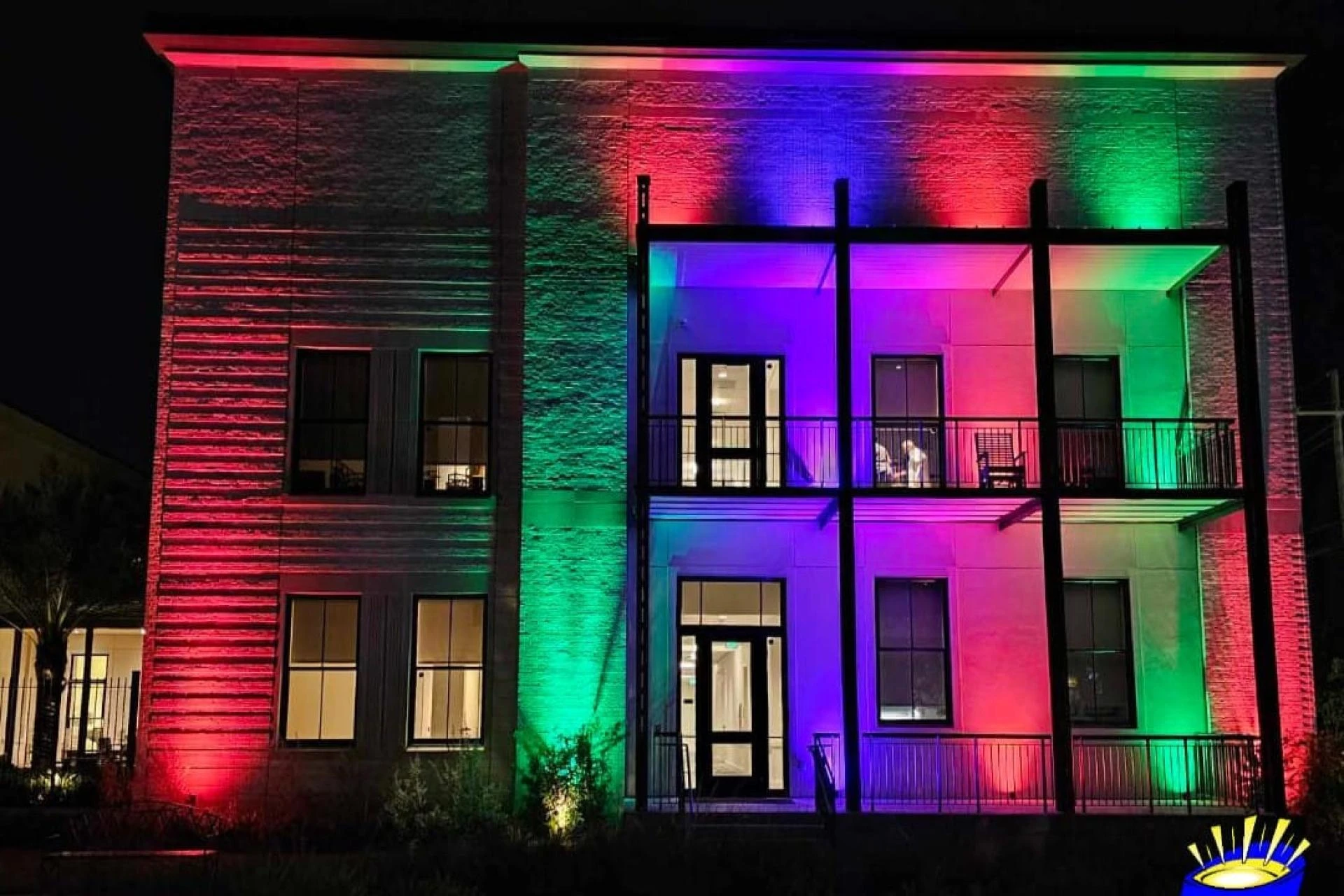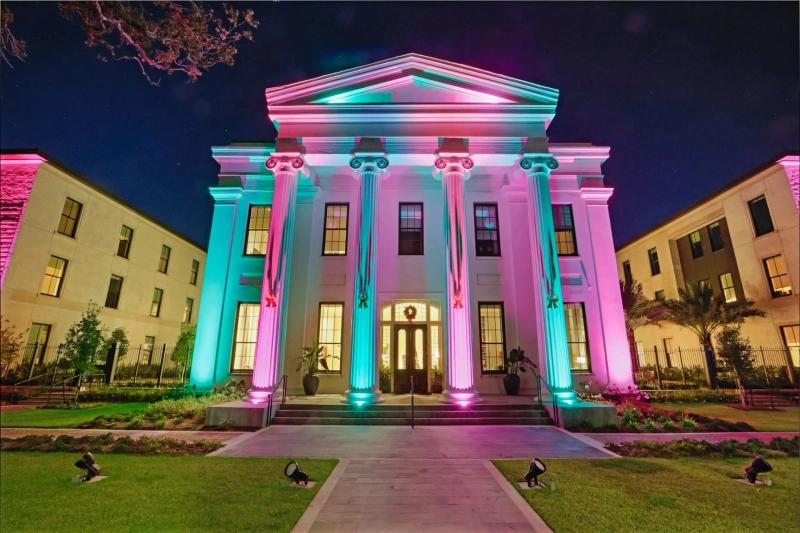Lighting does more than illuminate—it signals professionalism, safety, and care before a single customer steps inside. For commercial properties, investing in professional outdoor lighting often marks a turning point in how the space is experienced after dark. Each point below explores how exterior lighting connects to essential operational and design goals.
1. Increased Visibility Strengthens Identity
Recognizable businesses rarely fade into the background, even at night. A cohesive lighting plan ensures that building features, entryways, and signage remain visible, creating a clear and inviting presence. A financial services firm enhanced visibility by installing layered uplighting along its entrance and facade, which led to more consistent client arrivals during evening hours.
- Wall-mounted LED fixtures highlight signage from a distance.
- Linear lights installed near pathways improve navigation.
- Consistent lighting schemes help brand identity stand out after dark.
2. Improved Safety Reduces Risk
Accidents involving poor visibility are common around commercial spaces. Lighting that clearly defines walkways, curbs, and ramps helps prevent these incidents. According to the National Institute for Occupational Safety and Health, businesses with inadequate lighting experience higher rates of slip-related claims, especially during early morning or evening operations.
- Ground-level lighting provides clarity near steps and uneven surfaces.
- Bright overhead fixtures at loading areas support safe deliveries.
- Balanced light temperature reduces visual strain and improves awareness.
3. Strategic Lighting Prevents Criminal Activity
Security lighting sends a strong message—this property is active and monitored. When exterior zones are well-lit, loiterers and vandals are less likely to approach. The Bureau of Justice Statistics notes that lighting alone can decrease property crimes in commercial zones, particularly when paired with surveillance systems.
- High-mounted floodlights eliminate shadows near back entrances.
- Lighting near dumpsters and service zones discourages unauthorized access.
- Motion-activated systems can draw attention to unexpected activity.
4. Eye-Catching Lighting Attracts Customers
Customers are naturally drawn to warm, well-lit environments that feel comfortable and open. Exterior lighting can turn casual interest into store visits or dinner reservations. A retail strip saw an uptick in foot traffic by adding soft lighting to storefronts and decorative fixtures near display windows.
- Canopy lighting creates a welcoming feel for covered entrances.
- Adjustable accent lighting on signage captures attention from passing vehicles.
- Decorative sconces offer ambiance that supports longer customer stays.

5. Efficient Lighting Systems Lower Utility Spending
Old lighting setups are often costly and inefficient. Newer outdoor lighting technologies—especially LED systems—cut costs and last significantly longer than traditional bulbs. The U.S. Department of Energy estimates that LED solutions use 75% less electricity and perform reliably in harsh outdoor environments.
- Smart lighting timers adjust automatically based on sunset and sunrise.
- Dimming functions lower energy use during off-peak hours.
- Durable LED fixtures reduce replacement frequency and maintenance calls.
6. Lighting Enhances Architecture and Landscaping
Building details can be lost at night unless properly lit. Whether the design is contemporary or historic, thoughtful lighting can draw attention to texture, depth, and contrast that daylight often flattens. A hotel group emphasized stone columns and mature landscaping through subtle uplighting, resulting in improved guest impressions.
- Grazing light reveals architectural details in stone, brick, and metal.
- Low-voltage lighting along planters and walls adds layered dimension.
- Color-coordinated lighting enhances design themes without overpowering them.
7. Automated Lighting Systems Support Operational Consistency
Manually controlling exterior lighting wastes time and can result in inconsistent coverage. Automated systems simplify day-to-day management while ensuring the property remains properly lit throughout changing seasons or irregular business hours. Restaurants, gyms, and clinics all benefit from lighting schedules that align with customer flow.
- Scheduled timers adapt to daylight saving changes automatically.
- Integrated daylight sensors adjust output in real time.
- Lighting zones can be programmed individually for precise control.
Key Takeaways: Outdoor Lighting Benefits for Commercial Environments
Effective outdoor lighting isn’t a luxury—it’s a core part of maintaining safe, efficient, and welcoming spaces. Smart lighting supports everything from energy savings to branding without constant oversight. When these systems are properly planned, the results are tangible: lower risk, stronger identity, and higher customer engagement.
Highlights of Why Outdoor Lighting Helps Business Properties Thrive
- Strong visibility makes businesses easier to find and remember.
- Safety improves with well-placed lighting along paths and access points.
- Property crimes decline when exteriors are visibly illuminated.
- Better-lit storefronts draw more attention and increase dwell time.
- LED and automation systems offer long-term cost savings.
- Architectural and landscaping features gain visual impact at night.
- Automated controls keep lighting consistent through seasonal changes.
Frequently Asked Questions
What lighting color temperature is best for commercial exteriors?
Neutral white (around 4000K) is typically ideal for commercial spaces. It offers visibility without feeling too harsh or overly warm.
How often should outdoor lighting systems be inspected?
Quarterly inspections are recommended to check for debris, bulb outages, water damage, and sensor calibration.
Do commercial properties need permits to install lighting?
Yes, some municipalities require permits, especially when installing electrical components or large fixtures. Local regulations often address brightness and direction as well.
Is it possible to control outdoor lights remotely?
Yes. Many modern systems include app-based or cloud-connected controls that allow remote adjustments from mobile devices.
Can lighting be customized for seasonal or special events?
Absolutely. With programmable systems, color and timing can be adjusted for holidays, promotions, or special branding moments.


